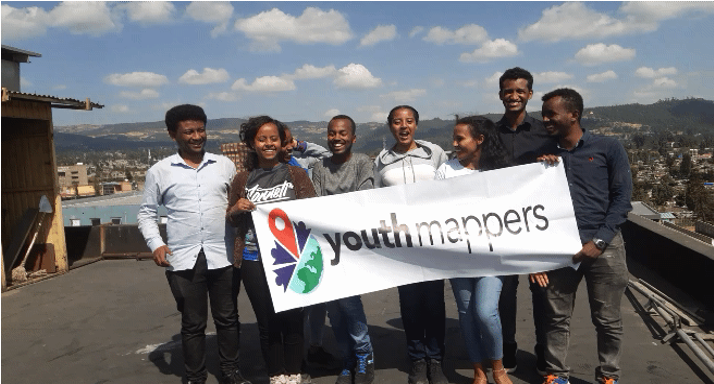SHARING IS CARING – How to ensure diversity inclusion among YouthMappers: Post-COVID-19.
- Stellamaris Wavamunno Nakacwa, Regional Ambassador
- May 21, 2020
- 5 min read
Updated: Aug 13, 2021
YouthMappers is a student movement across the globe building and steering generational leaders through application of open source and web-based geospatial technologies like OpenStreetMap(OSM). Through OSM contributions, a multitude of student participants/mappers gathers from around the world to build and strengthen resilience among their communities through several mapping projects including those addressing health [for example; #Mapping4COVID-19], sanitation, bad cultural practices and many development challenges.
Through these projects, the program is significantly grooming community resilient leaders; bridging the gap between the current trend digital tools and students’ resources but intrinsically tackling the technical questions of diversity throughout the entire program. Many strategies have since been established to ensure gender, racial, and nationality representation and participation. These strategies include the leadership fellowships, research fellowship, the Let Girls Map campaign and the regional ambassadors most of the ideas are inspired by the student’s community and especially chapter activities.
YouthMappers is not only seeking diversity through these strategies but also through the induced core activities practiced by individual chapters such as beginner/fresher reinforcements, mapping parties [Mapathons] and multi-discipline engagements to promote chapter activity, participation and survival.

Notwithstanding these generalships, some chapters and chapter leadership are constantly baffled with motivation and multi-discipline inclusion within their chapters, not to mention, have persistently struggled to have their chapters active and living up to date with community engagements. This brings us to the uttermost question during new chapter pieces of training of “What are the requirements for one to be part of the chapter?” Well, the answer is the only requirement, one must be a student and it does not matter their college or course as long as they have interest in learning and keeping abreast with open source mapping. Besides, this is our platform to build a community of a generation that is aware of how simple projects and work can be established by letting everyone engage in these kinds of activities.
All these, in the long run, lays a responsibility to the chapter leadership to ensure diversity, inclusion, participation and activity of the chapter even when the leadership transcends from one team to another. In this blog, I am sharing a few simple tips but magical, that can confer prosperous knowledge to the chapter leadership to drive their chapters to mapping glory.

a) Working as a team; The chapter leadership is not homogenous through the community of YouthMappers, however, there are modal positions that exist, at least for every chapter and that is; a president/Chapter Chair, vice-president/vice-Chair, a speaker/Chapter Publicity and a secretary.
This team must ensure ‘effective’ and constant communication amongst themselves. This is to enable them to fully design and lay team strategy that may include; scheduling chapter activities for the semester on the semester calendar, and ensuring these activities are also reflected on the general community calendar. Teamwork is very important, so one team member is not overwhelmed with too much to perform. The team must divide roles and also design control and checkpoints to ensure fulfillment of assigned tasks, while still modelling chapter excellence. A dedicated team will always proudly pocket progress of their chapter.

b) Keeping up to date with the chapter Mentor/Department; Yes! This is one of the hardest tasks for most chapters but there is no other way. Finding a chapter mentor is a chapter leadership tactics that must be employed. To be honest, it is easiest to go through one team’s closest professor/lecturer for a mentor, one that has been friendly and engaging for many students. As a team, you have to ensure securing recognition in an office because this relies upon the prosperity of student chapter activities such as access to a computer/GIS/Remote Sensing lab for mapping exercises. We must also note that our professors are so busy and thus we must correctly package our messages before we approach them. This means do not burden the professor with a lot of paperwork but importantly keep them up to date for every chapter step.
Also, some professors/mentors may demand proof of authenticity of the YouthMappers program and this is when the chapter leadership should consider reaching out to info@youthmappers.org to seek official introduction into the chapter existence. I salute the mentorship of University of Cape Coast Chapter’s Mr. James Eshun and Geo YouthMappers’ Prof. Anthony Gidudu, because these professors sacrificed some of their lecture periods for the chapter engagements instead.
The program also awards certificates of performance at every end of the year and chapters should present these certificates to their mentor’s/department’s office. With mentorship, a chapter is bound to vary in numbers and participation of students around campus.
c) Advertising across campus; This tip mainly appreciates Tobler’s first law of geography which indicates that near things are more related than distant things even if everything has a relationship with each other. That is to say, start with the closest community maybe your class, then slowly expand through your department until you can spread across the college/campus.
Advertising may be done by word of mouth, where the chapter leadership team moves from class to class introducing the chapter and reminding students of events. It does not matter whether your team already has a comfortable number, it is about building a culture and moving the gospel and you never know the team you are building. It also builds public speaking skills and confidence amongst the leadership team. Also, to add, this is the most effective form of advertising, especially to newly launched chapters. It is also a way to catch the attention of many professors/lecturers especially when you have to ask for a minute to announce your chapter activities.

Advertising may also be through posters printed and pinned across notice boards in the department/faculty buildings. These will catch the eye of passersby and students from other faculties that often tour across campus searching for a surprise. This, however, may still require subjection to last-minute reminder to the students, either through a word of mouth or using the magical tactic d).
d) Taking advantage of the digital recruitment and communication platforms; As students at university, it is certain that 90% of us are exposed to at least the Microsoft or google enterprise. This means that everyone has access to an email account through which they easily access information. As chapter leadership, take advantage of this platform to recruit and constantly remind members about virtual participation- a paramount premise of chapter activity.

Exploit platforms like google forms and Kobo Toolbox to recruit new interested members to the next event, by simply passing on a survey with a few simple questions and declaring the official date of the training. While this supports the chapter event planning, it is also one of the main ways to ensure inclusion of diversity across disciplines, gender and level of enrollment on campus. The community also constitutes an officer group through which each chapter leader connects to updates and can easily disseminate these to their members’ emails and as verbal reminders.
As well, social media platforms play a vital role in replenishing the chapter, through sharing and motivating. Therefore, at least every chapter must have a group where they can impulsively engage in discourse to their advantage, share joys and motivate activism and strategies for their chapter performance. These platforms are also a basis for virtual collaboration amongst the different chapters form the different universities, as well as, other open-source and OpenStreetMap communities. This is highly encouraged to initiate inter-continental mapping parties and virtual campus tours.
Also, alumni are available through these virtual platforms to readily convey leadership and technical support to ensure chapter diversity and proactive participation. I believe with at least some of these tricks embedded into our chapter leadership, chapter participation and motivation will not even suffer post-COVID-19 consequences. Do not forget to share with a friend when you read, because sharing is indeed caring.




Comments